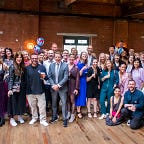Innovation in fast-moving times
The speed of change and growth across the business and customer landscapes shows no sign of slowing or getting any simpler. Rising demands and expectations combined with evolving regulations and market competition all impact business decisions made on a daily basis.
In our most recent Exchange, leaders from the global business community discussed practical ways of how we can survive, and hopefully thrive, by using innovation to understand and solve for the wants and needs of your colleagues, customers and consumers. Here are some of our conversation highlights:
Establishing where to place your bets: How do you decide what to focus on now, next and later?
- Proactive vs. reactive: A question for all businesses to answer — how do we differentiate to become leaders by being intentional about our time, not spreading ourselves too thin?
“Confusing movement with progress”
- Maturity in organisations: Immature companies are “confusing movement with progress” by following the ball and trends, not purposeful, innovation-led change
- Advocate for focus: We need to listen to people on the ground (customers and employees), develop principles and a clear story for change, and tackle issues one step at a time. A good book recommendation is Johan Hari’s Stolen Focus — our attention hasn’t plummeted, but it’s been stolen. Hari examines the 12 factors that negatively impact our focus and the steps we can take to get it back.
- Making a case for investment: Particularly in local government, it’s a hard sell to convince them to invest, so by bringing an innovative design thinking approach allows organisations to shift their mindset to be more business savvy through incremental change.
- Staying connected across the internal silos: What are the crucial skills your teams need to work together, thrive and get results?
“If you can’t say the thing, you can’t fix the thing”
- Create psychological safety: “If you can’t say the thing, you can’t fix the thing”, so encouraging contrarianism it can provoke conversation across groups.
- Show people the risk of NOT working together: This takes time, but begin with small steps by getting teams to start understanding the journey and the E2E experience.
- Don’t get hung up on the deliverables: We need to ensure that momentum is maintained, so sometimes playing the FOMO card can get results.
- Make remote teams stay better connected: There were many ideas here to maintain engagement, such as using Slack programmes to support psychological safety, Donut team building (www.donut.com), connect@breakfast, and face-to-face time together to make people feel seen and even loved by the organisation. Creating opportunities for outside work conversations is also important to help reduce isolation.
- Regional vs global: The scope is difficult when it’s global, leaders need to allow local teams to do their job and then feed that back into global. Having high level buy-in helps, but it’s also about creating empowerment for people to do design thinking day to day.
Join our Facilitation Masterclass on 13th August at 8.30am BST. This free one-hour taster session equips you with the skills to run successful and productive group sessions. You’ll learn how to establish objectives, create a safe and inclusive space, manage group dynamics and facilitate collaboration and effective communication.
If you have any questions, please email me at emma.chadwick@wearemagnetic.com
